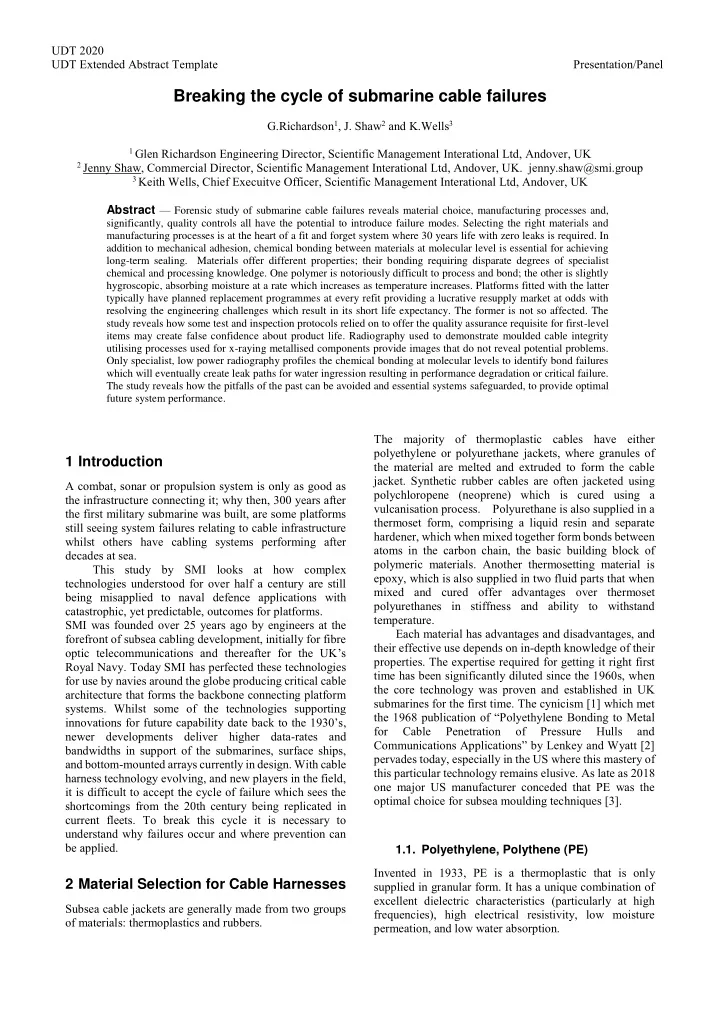

UDT 2020 UDT Extended Abstract Template Presentation/Panel Breaking the cycle of submarine cable failures G.Richardson 1 , J. Shaw 2 and K.Wells 3 1 Glen Richardson Engineering Director, Scientific Management Interational Ltd, Andover, UK 2 Jenny Shaw, Commercial Director, Scientific Management Interational Ltd, Andover, UK. jenny.shaw@smi.group 3 Keith Wells, Chief Execuitve Officer, Scientific Management Interational Ltd, Andover, UK Abstract — Forensic study of submarine cable failures reveals material choice, manufacturing processes and, significantly, quality controls all have the potential to introduce failure modes. Selecting the right materials and manufacturing processes is at the heart of a fit and forget system where 30 years life with zero leaks is required. In addition to mechanical adhesion, chemical bonding between materials at molecular level is essential for achieving long-term sealing. Materials offer different properties; their bonding requiring disparate degrees of specialist chemical and processing knowledge. One polymer is notoriously difficult to process and bond; the other is slightly hygroscopic, absorbing moisture at a rate which increases as temperature increases. Platforms fitted with the latter typically have planned replacement programmes at every refit providing a lucrative resupply market at odds with resolving the engineering challenges which result in its short life expectancy. The former is not so affected. The study reveals how some test and inspection protocols relied on to offer the quality assurance requisite for first-level items may create false confidence about product life. Radiography used to demonstrate moulded cable integrity utilising processes used for x-raying metallised components provide images that do not reveal potential problems. Only specialist, low power radiography profiles the chemical bonding at molecular levels to identify bond failures which will eventually create leak paths for water ingression resulting in performance degradation or critical failure. The study reveals how the pitfalls of the past can be avoided and essential systems safeguarded, to provide optimal future system performance. The majority of thermoplastic cables have either polyethylene or polyurethane jackets, where granules of 1 Introduction the material are melted and extruded to form the cable jacket. Synthetic rubber cables are often jacketed using A combat, sonar or propulsion system is only as good as polychloropene (neoprene) which is cured using a the infrastructure connecting it; why then, 300 years after vulcanisation process. Polyurethane is also supplied in a the first military submarine was built, are some platforms thermoset form, comprising a liquid resin and separate still seeing system failures relating to cable infrastructure hardener, which when mixed together form bonds between whilst others have cabling systems performing after atoms in the carbon chain, the basic building block of decades at sea. polymeric materials. Another thermosetting material is This study by SMI looks at how complex epoxy, which is also supplied in two fluid parts that when technologies understood for over half a century are still mixed and cured offer advantages over thermoset being misapplied to naval defence applications with polyurethanes in stiffness and ability to withstand catastrophic, yet predictable, outcomes for platforms. temperature. SMI was founded over 25 years ago by engineers at the Each material has advantages and disadvantages, and forefront of subsea cabling development, initially for fibre their effective use depends on in-depth knowledge of their optic telecommunications and thereafter for the UK’s properties. The expertise required for getting it right first Royal Navy. Today SMI has perfected these technologies time has been significantly diluted since the 1960s, when for use by navies around the globe producing critical cable the core technology was proven and established in UK architecture that forms the backbone connecting platform submarines for the first time. The cynicism [1] which met systems. Whilst some of the technologies supporting the 1968 publication of “Polyethylene Bonding to Metal innovations for future capability date back to the 1930’s , for Cable Penetration of Pressure Hulls and newer developments deliver higher data-rates and Communications Applications” by Lenkey and Wyatt [2] bandwidths in support of the submarines, surface ships, pervades today, especially in the US where this mastery of and bottom-mounted arrays currently in design. With cable this particular technology remains elusive. As late as 2018 harness technology evolving, and new players in the field, one major US manufacturer conceded that PE was the it is difficult to accept the cycle of failure which sees the optimal choice for subsea moulding techniques [3]. shortcomings from the 20th century being replicated in current fleets. To break this cycle it is necessary to understand why failures occur and where prevention can be applied. 1.1. Polyethylene, Polythene (PE) Invented in 1933, PE is a thermoplastic that is only 2 Material Selection for Cable Harnesses supplied in granular form. It has a unique combination of excellent dielectric characteristics (particularly at high Subsea cable jackets are generally made from two groups frequencies), high electrical resistivity, low moisture of materials: thermoplastics and rubbers. permeation, and low water absorption.
Recommend
More recommend